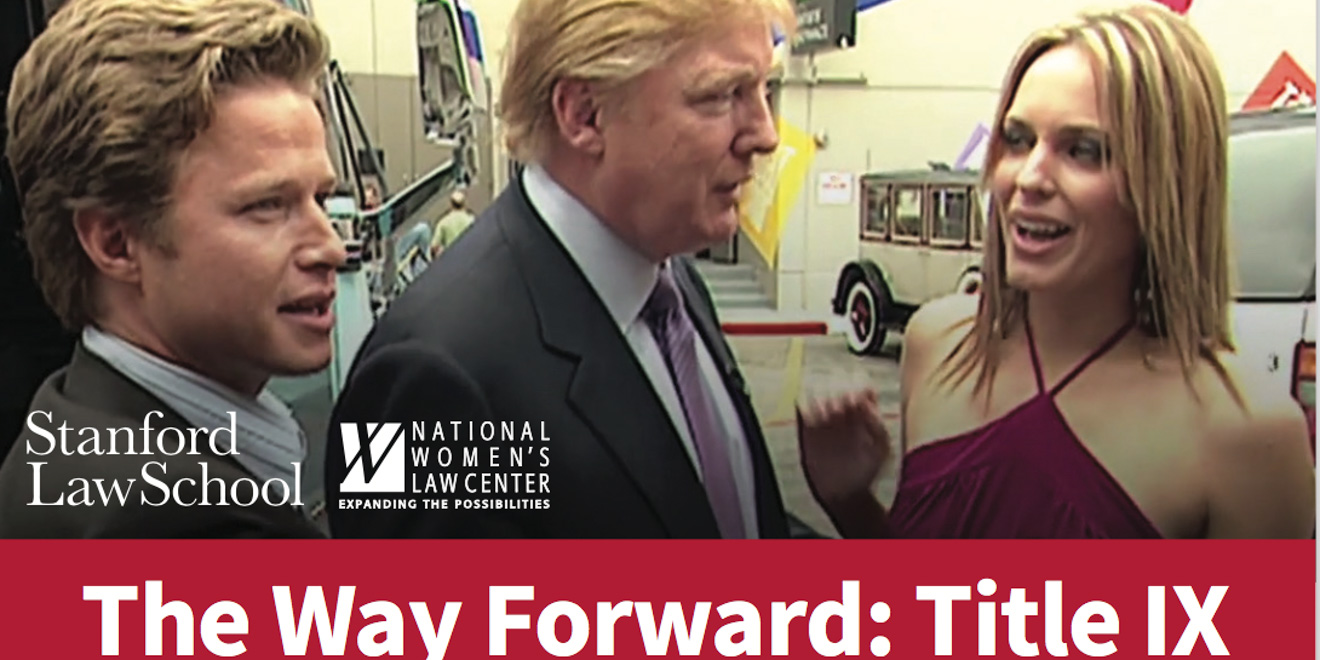Thrust into the spotlight over a claim of censorship, Stanford has allowed a conference examining Title IX under President Donald Trump to promote itself with an image of Trump that the Stanford Law School, a co-sponsor of the event, initially deemed too partisan.
“The Way Forward: Title IX Advocacy in the Trump Era,” set to take place May 1 and 2 at the Law School with the backing of a host of groups both on and beyond campus, will examine the future of national policy about sexual violence on college campuses. The event’s description cites “widespread concern” that the Trump administration will revise Obama-era expansions in Title IX enforcement. Conference organizer and Frederick I. Richman professor of law Michele Dauber wanted to illustrate the event’s website with a screenshot from a now-infamous video of Trump bragging about groping women.

Dauber’s tussle with Law School administration over the conference images began in early January, according to a series of emails she provided to The Daily, when her request to use the Trump screenshot was first refused. Dauber followed up unsuccessfully with a number of Law School staff, arguing that telling her to choose a different picture constituted censorship beyond what University rules called for. Administrators stated over email that the image would go against the University’s policy of political neutrality.
The dispute over conference promotion went public last Thursday when Dauber sought to use the rejected Trump image on conference posters, to which the Law School also objected.
Rather than seek a final opinion from the University’s General Counsel – which in February overruled the Law School’s objections to putting a photo of January’s Women’s March on the event website – Dauber reached out to The Guardian with complaints of censorship.
“I have been trying for months to get the university to allow the use of this image,” Dauber told The Daily over email. “I’m disappointed that it took media reporting in order for the University to honor its obligation to protect faculty academic freedom.”
University spokesperson Lisa Lapin said over email that Stanford would have approved the Trump picture regardless. She noted that Dauber reached out to press before the University had made a decision on the image, stating that Dauber said she would “think about” going to the General Counsel but did not actually request to do so. The General Counsel approved the Trump image within a day of the poster dispute, Lapin said, and posters and the website now bear the Trump photo.
Dauber, on the other hand, maintains that images should not have been blocked in the first place and says she went to the media because it was unclear whether the images could be approved in time for the conference.
Though Stanford’s General Counsel ultimately permitted the Trump picture, finding no specific violation of University guidelines on political activity, Lapin said the Counsel “did appreciate the Law School’s original concern … and that the Law School could choose not to use the photo in promoting its event.” She said the Law School’s actions reflected a desire to avoid the appearance of institutional endorsements and keep Stanford “a forum for open debate, even potentially contentious debate” when it comes to politics.
Dauber, meanwhile, calls the General Counsel’s view “incoherent” for defending the law school’s right to veto the picture despite deciding that it did not violate Stanford’s guidelines.
“The point of academic freedom is that sometimes challenging or difficult speech can make people uncomfortable and that is what we want to encourage at a university,” Dauber said.
On April 13, Dauber sent out fliers for the conference bearing the disputed Trump screenshot. Although it had been rejected for web, Dauber said she believed that the picture would not pose a problem on posters because she had referenced plans to do so in an email with administrators shown to The Daily. Again, the Law School objected. The school maintained its position when Dauber offered to remove the Law School’s name from the posters and pay for their printing herself.
“We have been clear since January that these Access Hollywood images could give the appearance of partisanship and since the event is an SLS-sponsored event, they shouldn’t be used in the marketing of the event,” wrote Sabrina Johnson, associate dean for communications & public relations at the Law School, in an email to Dauber. Johnson declined to comment to The Daily.
Asked why the topic of the event and title referencing Trump were not similarly problematic, Lapin wrote, “This is a policy conference convening experts to discuss important issues, which is common at any university.”
Another administrator with whom Dauber spoke on April 13 offered to refer the matter to the General Counsel. According to an email obtained by The Daily, the administrator – who declined to comment for this story – told Dauber there was no guarantee the Counsel would respond as quickly as it had before, although the administrator could try to help. Previously, emails show, the General Counsel took nine days to return its decision on the Women’s March poster. Dauber opted to contact media.
Expanding on academic freedom issues she sees with the Law School’s oversight of conference promotion, Dauber said that school’s level of sponsorship for the event is minimal. The conference is primarily funded by $50,000 of a grant she received to support work on sexual assault rather than by the school, which she says is only contributing personnel such as event staff (even the posters, she said, come courtesy of Stanford in Government).
“If a professor can be censored merely because they work at Stanford and their speech is occurring in a building on campus or the support staff help them with it that would mean there is no protection at all for faculty speech,” Dauber said.
Lapin said that regardless of the amount of resources contributed, the conference still uses the Law School’s name and has used the school’s communication channels.
“The issue with the publicity photo is that it was school communication, not personal faculty communication,” she wrote.
Dauber said that she was denied the opportunity to engage in personal communication when she was not allowed to distribute posters without the Law School logo on her own.
“I explicitly asked whether I could remove all of Stanford’s brands and the name Stanford from the flyer in order to get through this quickly and quietly and Sabrina refused,” Dauber said, though her later decision to contact media would ensure the dispute was anything but quiet. “That is what caused me real alarm, and so what Lapin is saying makes no sense.”
However, according to emails shared with The Daily, administrators corresponding with Dauber at the time emphasized the Law School’s overall sponsorship, rather than the logo, as a sticking point.
Contact Hannah Knowles at hknowles ‘at’ stanford.edu.
The article has been updated to reflect that the Trump image is now on posters and the event’s website. A previous version of this article also incorrectly paraphrased Lapin on the Law School’s contributions to the conference. The Daily regrets this error and has expanded on the issue of the conference’s backing. Other updates added and provided context for Dauber’s response to Lapin’s quote about school communication versus personal communication.
